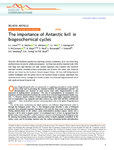The importance of Antarctic krill in biogeochemical cycles
| dc.contributor.author | Cavan, EL | |
| dc.contributor.author | Belcher, A | |
| dc.contributor.author | Atkinson, A | |
| dc.contributor.author | Hill, SL | |
| dc.contributor.author | Kawaguchi, S | |
| dc.contributor.author | McCormack, S | |
| dc.contributor.author | Meyer, B | |
| dc.contributor.author | Nicol, S | |
| dc.contributor.author | Ratnarajah, L | |
| dc.contributor.author | Schmidt, Katrin | |
| dc.contributor.author | Steinberg, DK | |
| dc.contributor.author | Tarling, GA | |
| dc.contributor.author | Boyd, PW | |
| dc.date.accessioned | 2020-07-01T15:50:59Z | |
| dc.date.issued | 2019-12 | |
| dc.identifier.issn | 2041-1723 | |
| dc.identifier.issn | 2041-1723 | |
| dc.identifier.other | 4742 | |
| dc.identifier.uri | http://hdl.handle.net/10026.1/15826 | |
| dc.description.abstract |
<jats:title>Abstract</jats:title><jats:p>Antarctic krill (<jats:italic>Euphausia superba</jats:italic>) are swarming, oceanic crustaceans, up to two inches long, and best known as prey for whales and penguins – but they have another important role. With their large size, high biomass and daily vertical migrations they transport and transform essential nutrients, stimulate primary productivity and influence the carbon sink. Antarctic krill are also fished by the Southern Ocean’s largest fishery. Yet how krill fishing impacts nutrient fertilisation and the carbon sink in the Southern Ocean is poorly understood. Our synthesis shows fishery management should consider the influential biogeochemical role of both adult and larval Antarctic krill.</jats:p> | |
| dc.format.extent | 4742- | |
| dc.format.medium | Electronic | |
| dc.language | en | |
| dc.language.iso | en | |
| dc.publisher | Springer Science and Business Media LLC | |
| dc.subject | Animals | |
| dc.subject | Antarctic Regions | |
| dc.subject | Biomass | |
| dc.subject | Carbon | |
| dc.subject | Carbon Cycle | |
| dc.subject | Euphausiacea | |
| dc.subject | Food Chain | |
| dc.subject | Seawater | |
| dc.subject | Spheniscidae | |
| dc.subject | Whales | |
| dc.title | The importance of Antarctic krill in biogeochemical cycles | |
| dc.type | journal-article | |
| dc.type | Journal Article | |
| dc.type | Research Support, Non-U.S. Gov't | |
| dc.type | Review | |
| plymouth.author-url | https://www.webofscience.com/api/gateway?GWVersion=2&SrcApp=PARTNER_APP&SrcAuth=LinksAMR&KeyUT=WOS:000490981900011&DestLinkType=FullRecord&DestApp=ALL_WOS&UsrCustomerID=11bb513d99f797142bcfeffcc58ea008 | |
| plymouth.issue | 1 | |
| plymouth.volume | 10 | |
| plymouth.publication-status | Published online | |
| plymouth.journal | Nature Communications | |
| dc.identifier.doi | 10.1038/s41467-019-12668-7 | |
| plymouth.organisational-group | /Plymouth | |
| plymouth.organisational-group | /Plymouth/Faculty of Science and Engineering | |
| plymouth.organisational-group | /Plymouth/Faculty of Science and Engineering/School of Geography, Earth and Environmental Sciences | |
| plymouth.organisational-group | /Plymouth/Users by role | |
| plymouth.organisational-group | /Plymouth/Users by role/Academics | |
| dc.publisher.place | England | |
| dcterms.dateAccepted | 2019-09-25 | |
| dc.rights.embargodate | 2020-7-3 | |
| dc.identifier.eissn | 2041-1723 | |
| dc.rights.embargoperiod | Not known | |
| rioxxterms.versionofrecord | 10.1038/s41467-019-12668-7 | |
| rioxxterms.licenseref.uri | http://www.rioxx.net/licenses/all-rights-reserved | |
| rioxxterms.licenseref.startdate | 2019-12 | |
| rioxxterms.type | Journal Article/Review | |
| plymouth.funder | Processes Influencing Carbon Cycling: Observations of the Lower limb of the Antarctic Overturning (PICCOLO)::NERC |


